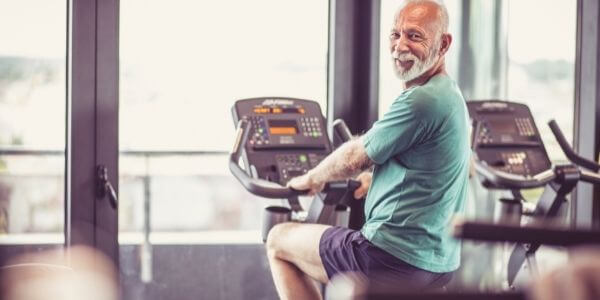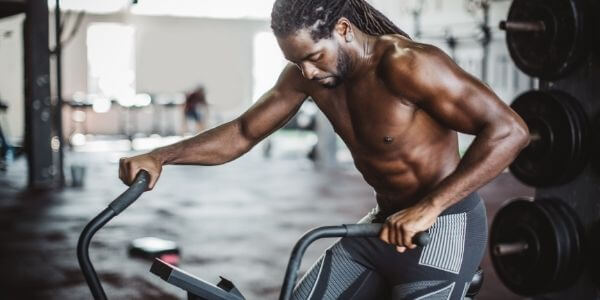Stationary bikes are a top go-to choice for home fitness equipment. They’re easy to use in front of the TV, don’t require a lot of effort, and lead to fast weight loss.
But few people recognize the risks of using stationary bikes.
We’ll discuss those hazards below, after first reviewing the advantages:
Table of Contents
10 Exercise Bike Benefits
Stationary bikes have lots of advantages you already know, such as their convenience. Besides, some models are portable and foldable to save a lot of space in your home, while others have a slew of programs to help you train effectively. You can even purchase gym-grade exercise bikes.
Here are some other strong points to consider:
1. Better Cardiovascular Health

Every time you hop on that bike and start moving your legs, your heart starts working too. The first advantage of a stronger heart – or the first one you’ll notice – is that your blood pressure will decrease.
As a result, your blood circulation will improve, reducing the risk of chronic or acute conditions. For example, you’re decreasing the chances of having a heart attack.
Remember: You’ll see improvements in a few weeks, but you need to challenge yourself. Try to pedal at least 3-4 times per week and a minimum of 20-30 minutes per session.
Also, remember that people have different levels of fitness. If you’re doing just 5 km/h but challenging yourself, that’s still an excellent starting point for your body.
2. Improved Brain Health
Your brain gets a kick out of cardio workouts that make your heart and lungs stronger. That’s because that extra kick of oxygen and blood flow goes straight to your brain.
As such, your command center can do its job better.
It takes just a few days to see that you’re sleeping better and are generally in a better mood. You’ll have more energy throughout your day in a week or so, and you won’t feel any brain fog.
Soon you’ll see mid or long-term advantages, too, such as improved memory and a more robust immune system.
3. Improved Breathing

Many people believe that stationary bikes increase lung capacity, but that’s just a myth. Your lungs’ volumes won’t expand if you’re using an exercise bike.
Here’s what happens instead:
Your heart pumps blood more effectively, and your muscles are more robust. That means they demand less oxygen to perform better.
Notice how you’re gasping for breath during your first few sessions, but each time you exercise, your breathing stabilizes?
That’s your lungs working less because your muscles don’t need extra oxygen. Therefore, you’re improving your breathing.
If you have chronic respiratory issues like asthma or chronic lung disease, exercise bikes may help alleviate your symptoms.
Warning: Ask your doctor for advice if you have preexisting heart and lung conditions.
4. Weight Loss
An hour of intense exercise on your stationary bike burns about 300 calories each 30 minutes. That’s about a slice of pizza or a donut.
However, how fast you’re shedding those pounds depends on several factors:
- Your current weight
- Age
- Biological sex
- Current fitness level
- Preexisting endocrine issues
- The intensity of your workout
For example, a 35-year-old male who weighs 250 pounds, who’s not very active but has no endocrine issues, can burn up to 300-400 calories on the exercise bike if he’s maintaining a high impact.
On the other hand, a 50+ petite female with hypothyroidism may burn just 100 calories during the same period and at the same intensity level.
Advice: If you want to lose more weight faster, choose a HIIT type of workout that accelerates your metabolic rate. Also, wear a heart monitor so that you’re exercising in your fat-burning zone.
5. Fat Loss

Losing weight is one thing; losing fat is another. Many people who’re doing mindless cardio shed a lot of water weight when they first start exercising. Afterward, they experience a plateau and get demoralized entirely, so they quit exercise altogether.
So, studies show that if you’re serious about losing fat weight, you have to:
- Use your exercise bike for 45 minutes/ day, three times per week
- Restrict your calories
We’d add that drastic calorie restriction isn’t your best bet in the long run. While it can have some effects in the short term, your body can’t benefit from just 1200 calories/ day like the participants in the above study ate.
Instead, eat to nourish your body. Stick to healthy foods and limit your cheat days!
Pro tip: You can lose fat weight faster if you’re doing high-intensity interval training (HIIT) on your bike and incorporating strength training into your routine.
Besides, this fat loss isn’t just to shape your body in a particular way. It’s recommended because it will lower your harmful cholesterol levels.
And guess what:
That high number of triglycerides you see on your blood test results causes many problems in your body, such as clogged arteries and chronic liver issues.
6. Low-Impact workout
Exercising on a stationary bike protects your joints and ligaments because you’re executing fluid motions. That way, you can strengthen your muscles and bones without damaging them.
So, an exercise bike benefits the elderly or mobility-challenged people. It can also help you if you’re pregnant or recovering from surgery.
However, if you’re going to use your stationary bike for rehabilitation, check with your doctor or physical therapist first. They’ll be able to discuss the pros and cons of several types of bikes, from upright to recumbent, to see what fits you best.
7. Stronger Muscles

Everybody knows that using a stationary bike exercises your leg muscles. The harder you’re pedaling and the higher the resistance, the better you’ll shape your legs.
That doesn’t mean low-speed, and low-resistance levels are useless.
This is a great place to start to warm up or even exercise if you have mobility issues. It’s an excellent starting point if you want to improve your fitness level.
The point is to challenge yourself but not put yourself through painful workouts. That’s how you’ll shape and tone your muscles.
However, it’s also true that only high resistance levels can increase your muscle mass.
Here’s a secret that not many people know: working out on an exercise bike benefits stomach muscles.
The reason is that you’ll keep your abs and lower back muscles contracted throughout your workout. And obviously, higher speeds and resistance levels demand more contraction, so your core will be more toned.
Apart from stationary bike benefits for legs and core, pedaling tones your arms too.
Here’s how that works:
You’ll contract your biceps and triceps when gripping the handlebars, especially during intense pedaling sessions. You’ll also contract these muscles when you’re standing up in the saddle.
However, you’ll feel this workout in your upper body mainly at the beginning when you’re new to pealing. After a while, though, your arms will get used to the effort because they’re just supporting muscles; you’re not targeting them specifically.
So the best advice if you want to tone and shape your entire body is to dedicate 2-3 days per week to focus on your upper body and core.
8. Safe
Pedaling on a stationary bike is safer than pedaling outdoors, especially if you’re a newbie. Accidents and injuries are frequent on the roads, especially in humid or foggy weather.
Instead, pedaling indoors saves you a lot of hassle. You can start doing it first thing in the morning to dissipate your brain fog or just before bed. That’s when most people have enough free time.
While exercising outdoors when you’re tired can bring your exhausted brain some extra fresh air, it’s more dangerous. Remember that you’ll have to watch out for incoming cars or road conditions. If you’re not used to cycling, staying safe can be tricky.
9. Reduced Risk Of Diabetes

Whether you’ve been diagnosed with pre-diabetes, diabetes, or a high risk of developing this condition, know that any endurance-based sport can help you. When you’re doing this type of exercise, your muscles use more of the glucose that would otherwise spike in your blood.
And guess what the best low-impact endurance sport you can do in your living room is.
Yes, stationary bike riding!
Apart from reducing your blood glucose, riding an exercise bike stabilizes insulin levels. When you have diabetes, your body secretes a lot of it because it’s no longer responding accurately to the needed amount of this hormone.
In turn, exercise decreases your body’s insulin sensitivity so that your pancreas won’t have to secrete so much of it. That way, pedaling on your indoor bike regulates your blood and insulin levels naturally.
10. Better Mood
Exercise, in general, improves your mood and reduces stress.
Firstly, exercise helps because it accelerates endorphins and serotonin – hormones that make you feel happy. Riding your stationary bike also increases dopamine production so that you can feel accomplished too.
Secondly, exercise reduces cortisol levels. In case you didn’t know this, cortisol is the stress hormone, so it’s the one to blame for your sour moods, anxiety, and crankiness. Besides, excess cortisol tires your brain, so it causes exhaustion, hazy vision, and the feeling of a stuffed head.
Exercise bikes promote the production of happiness hormones and reduce your cortisol levels. However, you have to exercise regularly and spend at least 30-45 minutes pedaling to feel a genuine runner’s high.
4 Exercise Bike Risks

Using an exercise bike has its risks, but only if you’re doing this wrong.
So let’s start with the most common mistake: overdoing it. This leads to:
1. Weight Loss Plateaus
Many people who want to get in shape start pedaling for hours at a time, trying to lose weight faster. And though it’s technically accurate you can burn up to 600 calories/ hour – it’s not necessarily true that you’ll always burn 600 calories/ hour.
If you’re starting at a high weight point, you’ll see massive effects after the first few weeks. But if you’re doing prolonged cardio sessions on your stationary bike, your metabolic rate will slow down as your heart gets used to the effort.
So after a month or two of overdoing it, your weight loss will stagnate, or you’ll even start putting on those pounds again.
Here’s how to avoid that:
- Limit your exercise to 45 minutes/ day
- Structure most of your workouts in high/low-intensity intervals
- Don’t use your exercise bike daily; do strength training on your break days
2. Injury
Overdoing it on your exercise bike increases your risk of injury. The first thing you’re going to notice is that sore bum, but that’s not the worst part.
The worst part is straining your muscles and ligaments.
Muscles need recovery days to repair after intense effort. If you’re not letting them heal properly, they won’t grow properly.
Besides, over-exercising pulls on your joints, so you’re more likely to twist them.
3. Loss Of Motivation

Working out very hard and for very long feels like a punishment, so instead of increasing your dopamine levels, you’re growing your cortisol. You’re subjecting your body and brain to a lot of stress.
At the same time, your muscles won’t have time to repair themselves, and your weight loss will plateau. These things will bring your motivation down a few notches too.
So the best thing you can do is know when to rest.
4. Ignoring Other Exercise
Training on your stationary bike all the time makes you ignore other types of exercises that you should include in your workout.
For example, if every day is leg day, when is upper body day?
Secondly, remember that riding a stationary bike isn’t a full-on weight-bearing exercise. So if you want to increase bone density and strengthen your bones, you should alternate bike riding with weight-bearing activities, such as walking, running, or strength training.
In Conclusion
Riding a stationary bike has a lot of benefits for your health. It keeps your heart and lungs healthy, it protects you from diabetes, and it keeps you happy. At the same time, this exercise is fantastic for shaping your body and improve your sleep.
The only risks of exercise bikes stem from using them too much. Overdoing it will slow down your weight loss, affect your joints, muscles, and motivation.
So, if you want to reap the advantages of a stationary bike, you should choose the right model for your needs and integrate other workouts into your routine.
- 7 Exercises for Pregnant Women in the First Trimester: Safe and Effective - January 30, 2025
- Our equipment recommendations - October 30, 2024
- Here’s What Doing Cardio Every Day Does To Your Body - August 21, 2024

